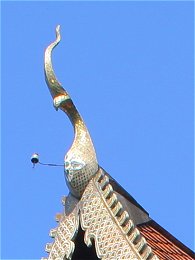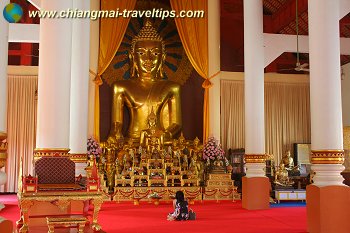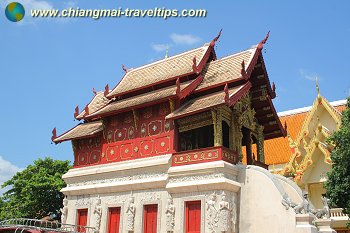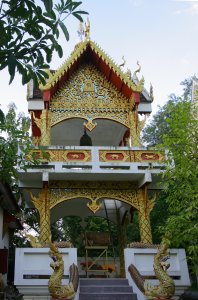One Thai temple is like another Thai temple, right? To the untrained eye perhaps, but Northern Thailand has its own temple architecture that is distinct from Central Thailand. On this page, we will get to know the different components of Northern Thai temples, so that when you explore them in Chiang Mai, you will be able to distinguish the different parts. We have also put together a Glossary of Northern Thai Temple terms, so that you can easily find out the definition of each term used.
The temples in Chiang Mai are the result of influences from its immediate neighbours Laos and Myanmar, and farther afield places like Sri Lanka and China. Within Northern Thailand itself, each valley has its own variation in temple design. However, as Chiang Mai is the most significant city in Northern Thailand, the style of Chiang Mai tends to be seen in the other valleys in Northern Thailand.
You will find the name or word "wat" used to describe Thai temples. Wat can be translated as temple as well as monastery. It is certainly a loose translation, as a Christian concept of temple and monastery in English is different from wat in Thai. For the sake of clarity, we will use the words wat and temple interchangeably, and within this context, they refer to Thai religious buildings that could be a temple, monastery or archaeological monument.
Visiting a Northern Thai temple
Imagine that we are now paying a visit to a temple in Chiang Mai. The first thing we notice, is that the temple, or wat, is enclosed by a wall. The wall, often white washed, usually encloses a rectangular area. The wall demarcates the temple compound, called putthawat, or the sacred enclosure. In olden days, you need to remove your shoes to enter the phutthawat, but nowadays, you only do that to enter the buildings. In Myanmar, Sri Lanka as well as at Wat Lai Hin near Lamphang, you are still expected to take off your shoes to enter the temple compound. Ideally but not always, the main entrance faces east.Viharn
The first building that we see - the main building - as we enter the temple, is called a viharn. Even in the smallest village wat, if it is a wat at all, it would have a viharn. In big temples, there would be many viharns. The viharn is the assembly hall that is used by both the laity and the monks. You are free to enter it after removing your shoes, but before we do that, let's walk around it and I'll point out some elements of the designs that is general to all Thai temples, and some that differentiate Chiang Mai temples from those in Bangkok. In fact, it is closer is style to those in Laos, where it is called sim.The viharn faces east. That's the same for all Thai temples. What's different, between Chiang Mai and Bangkok styles, is that in Chiang Mai, you will notice the wall are particularly low, that the eaves are much closer to the ground. Compare Wat Chedi Luang of Chiang Mai (left photo) with Wat Thewarat Kuchon of Bangkok (right photo).

In this photo, we see that the roof comes down close to the ground. That's the Chiang Mai, or Lanna, style of temple design.
 Here we see the roof high up, supported by taller columns. That's the Bangkok, or Central Thai, style of temple design.
Here we see the roof high up, supported by taller columns. That's the Bangkok, or Central Thai, style of temple design.
Singha
Before entering the viharn, you will often notice a pair of lions guarding the entrance. These mystical beasts are called singha, and in Chiang Mai, they are often made in the Burmese style. In Myanmar, the singha is called chinthe. In the Malay archipelago, it is used as singa, meaning "lion", and lends itself to "Singapore" without any religious connotation. Nak sadung
Nak sadung Makara
Makara
Nak Sadung and Makara
As you stand in front of the viharn, you notice a pair of balustrades coming down in the form of undulating naga. The undulating naga is called nak sadung. Take a good look at the naga, and you will notice that it is actually coming out of the mouth of another beast, called makara, a mystical water beast with features of the crocodile, elephant and fish. Front gable of Wat Phan Tao.
Front gable of Wat Phan Tao.
Gable
The front gable of the viharn is usually highly decorated. The design varies from temple to temple, according to the ability of the builders and the wealth of the temple. Many gables may also be divided into rectangular panels, as seen in the example on the right. A viharn at Wat Jetawan showing example of the kong khieu
A viharn at Wat Jetawan showing example of the kong khieu
Kong Khieu
The pelmet above the pillars are decorated to represent the eyebrows of the Buddha, and are called kong khieu. It is shown in color in the photograph on the right.
The sum at the ubosot of Wat Phra Singh
Sum
also called sum khong, the sum is an elaborate decorative arch over and framing the doorway. A viharn at Wat Phra Singh with a three-tier roof in two sections,
A viharn at Wat Phra Singh with a three-tier roof in two sections, upper and lower.
The Roof
The roof of Thai temples typically composed of three superimposed tiers, with the lowest tier over the porch. The number of tiers can range anywhere from one to four, with three being the most common. In addition, each tier may comprise of two or three sections. The lowest section is close to the ground, and spreads out like a mother hen spreading her wings to protect her chick.Now let's take a closer look at the roof.

Cho Fa
The roof ridges point upwards with a finial called cho fa, meaning "sky cluster". The design is in the form of a stylised garuda, which is meant to be grabbing the tail of the naga that flows down both sides of the bargeboard, pan lom.
Pan Lom
The bargeboard that covers the end of the gable, preventing the tiles from falling off, is called pan lom. It is often decorated like a downward sloping body of the naga, with its head rearing up. The naga's scales which project up is called the bai raka.
Hu Chang
Hu Chang, meaning "elephant ears" are the eave-brackets along the outer wall of the viharn. This is a triangular piece of wood that is often highly ornamented. The design can be in the form of intertwining naga, called nak kieo, a naga on its own, called nakkhatan, the monkey king Hanuman, or the mystical bird kinnari or other mystical beast.Inside the Viharn
Inside the viharn, you will find a Buddha image. Whether it is seated or standing, the Buddha image will be at the far end of the hall and face east, for that is the direction that Buddha achieved Enlightenment. Buddha image inside a viharn
Buddha image inside a viharn

Ku
Some times, the principal Buddha image may be very small. To enhance its presence, it is housed in a reliquary in the form of a miniature chedi, called ku.Structures within the compound
Coming out of the viharn, let's explore the other structures within the compound of the Northern Thai temple.Chedi

The chedi, or stupa, is probably the most distinctive element of any Thai temple. It comprises different sections, not all of which may appear on every chedi.
At the very top is the hti, (see below). Next is the spire with circular mouldings. Below it is a shaft, if present, then it occupies a short section and slimmer than the spire above it. Below that is the harmika, a short square structure that represents the throne of the Buddha. Below that is the relic chamber.
The base of Northern Thai chedi is large, square, and retented at the corners. It sits on a terrace or platform, often with an enclosed walkway for devotees to make ritual circumnambulation.
If the chedi contains relics of the Buddha himself - his hair, a piece of bone perhaps - then the chedi is called a phra that. In such a case, the base is also enclosed by a railing or fence, not only to guard the ritual circumnambulation, but also to guard it from defilement.
 Hti
Hti
Hti
The hti (pronounced "tee"), is a bejeweled sacred umbrella that sits at the topmost part of the chedi. The hti is a Burmese influence to the design. In addition, gilded parasols also adorn the four corners of the walkway surrounding the chedi. Chat
ChatChad
The chat is a Burmese-style sacred filigree parasol that are usually installed at the corners of the railings enclosing the chedi. These parasols are usually gilded.
Ubosot
The ubosot, also called the bot, is the consecrated ordination hall, used exclusively by monks. It is usually smaller in size compared to the viharn, which laypeople enter. Women are not allowed to enter the ubosot, and as the building is intended for the use of monks only, it may also be locked. The monks make daily prayers here. If you're standing in front of the main viharn, you will find the ubosot to the left and set back, that is, to the southwest of the viharn. Both face east.The consecration of the ubosot involves the burying of nine granite spheres, called luk nimit.

Phra Rabieng
The phra rabieng is a cloister that encloses the temple compound. Along the walls of the phra rabieng are Buddha images and some times religious furniture.Note: I shot the above photo of a phra rabieng in Ayutthaya. Unfortunately I couldn't find a single photo showing a phra rabieng in any of my shots of Chiang Mai.

Luk Nimit
Luk nimit are sacred marker spheres that will be buried during the consecration of the ubosot. They demarcate the sacred space. There will be nine luk nimit buried, one at the centre, four at the corners and four at the cardinal points in the middle of each side of the building.
Ho Trai
Ho trai or "manuscript repository" is only found in bigger temples and monastery. This is where the handwritten Buddhist manuscripts are stored. It is just a small building, but built raised up from the ground, to keep it away from termites and damp. The manuscripts were written on dried palm leaf.Like ho trai follows the same style as the viharn and ubosot, and is often lavishly decorated. It is very much a thing of the past, as today, Buddhist manuscripts are readily available in printed form.

Ho rakhang, or bell tower.
 The huge gong at Wat Phra That Haripunchai in Lamphun
The huge gong at Wat Phra That Haripunchai in Lamphun
Ho Rakhang
Ho rakhang is a bell tower. The bell is struck to call the monks to devotions, to announce time (it is struck for noon, after which monks are not allowed to eat) or to announce the stopping of work for the day.In some big temples and monasteries, there may also be a gong tower, or a combination of bell and gong.

Mondop
Mondop is a square, open-sided pavilion with a multi-tiered pyramidal roof rising to a peak.
Sala Gan Parian
Sala gan parian are open-sided preaching hall. This is a Bangkok-style structure that is only found occassionally in Northern Thailand. [an error occurred while processing this directive] Latest updates on Penang Travel Tips
Latest updates on Penang Travel Tips
 Map of Roads in Penang
Map of Roads in Penang
Looking for information on Penang? Use this Map of Roads in Penang to zoom in on information about Penang, brought to you road by road.Disclaimer
Please use the information on this page as guidance only. The author endeavours to update the information on this page from time to time, but regrets any inaccuracies if there be any.
Copyright © 2003-2025 Timothy Tye. All Rights Reserved.

 Go Back
Go Back